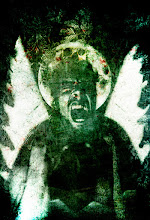Caesar Mitanni are produced in a hardish plastic which resists many base-coat techniques. They also have a certain amount of warping caused by packaging. I used very hot water to straighten spears, and "set" them in cold water. This technique is not foolproof: as minis heat up again the warp can return. Once cleaned up and washed with detergent, I used Tamiya Black paint to undercoat. This is a very hardy paint that grips plastic better than other acrylics do. Once fully dry, I smudge-coated each with white. ("Smudge" is midway between dry and wet - a good amount of paint coats all raised surfaces but hollows are left lightly brushed.)
Because the heavies are clad from top of helm to ankle in bronze-studded leather, I use an unorthodox approach to the next stage. Normally, flesh comes first then one paints in order from undergarment to outer to equipment. But in this case a wash with a light leather colour (a mix of yellow and leather) provides a large short-cut.
Flesh is next. This is a calculated risk, because I have yet to dry-brush with bronze. The bronze dry-brushing convincingly conveys the bronze-studded effect to their outer armour and shield. I've found with previous attempts that the dry-brushing needs to be fairly accurate, so I'm hopeful I won't have to re-touch the flesh too much. The idea is that only a second, lighter flesh tone will be needed later.
Once the bronze is on, dry-brushed with a fairly moist brush, the heavies are looking very close to complete. But that's an illusion: there's quite a bit of detail to go! They wear a variety of sleeved, sleeveless, calf- and full-length robes under the armour. (Caesar sculpting ought to show archers with sleeved garments with a wrist-guard, but it's not present.) So now we're returning to the "traditional" approach of painting from the inner, out.
I paint fabric over with white or yellow. This includes the tassel of each helmet. I also put a thin wash of white or yellow onto the central square of each shield. Next, I paint over most yellows with red, or at least add a red band on a fabric panel. For the whites, I add a variety of colour: maybe one has solid light blue, another solid white, another a blue stripe. It should be a lot more detailed but simple often looks better.
With the fabric finished it's time to move on to the browns. With a yellow-leather I go over each shield inner, then adding a deeper brown I paint spear shafts and bows, and finally beards.
Now that all basic colours have been completed, it's time to add the extra detail and touchups. The main portion of this for these figures is simply the second run of flesh, done in a much lighter tone and concentrating only on the raised surfaces. This both removes the bronze dry-brushing that carried over to the original flesh coat, and picks out flesh dimensions. Otherwise the fine detail is simply a few corrections of over-paints, and arrow shafts and fletching.
Next the hardest part of any true 1:72 mini: the eyes. Probably nine in ten mini painters have steadier hands and better eyes than me, so let's just say a procedure that often works is this:
- get the flesh highlights done (above)
- put a patch of white into each eye socket
- put a very thin line of brown onto each eyebrow, or just under the helm rim if the helm sits low
- try to work a second very thin line of brown from the outer, lower eye socket across to the centre, and perhaps leave a small extra brown mark where the pupil could be. The ideal result looks like a comma on its side, curl upward, but just a smaller horizontal line of brown than the brow line will work.
- mix tan/leather and white to a deeper shade than the face base flesh, and with it, draw a diagonal line from the inner eye socket, side of nose and to the cheek.
- mix tan and white to a pale, pale tan, and re-highlight the nose, cheekbones, and possibly the brow between the eyebrows, especially if you ended up with a unabrow look.
A few "gold-bronze" highlights on the armour, and the minis are ready for varnishing. I use an acrylic stain, very tough and flexible. The stain provides the effect of lining and shadowing, without needing to work for it, though the trade-off is that white looks dirty-white.
These lads are good to go to basing. I'm adding a couple of previously-completed spearmen retrieved from the Hittites. They always looked out of place. This brings me to four heavy archers, and ten spearmen. I do a 4Bw base, a 4Sp base (which will probably be used as 4Bd for Canaanites) and two 3Sp bases, which can be used as Ax for my Mitanni, though not convincingly.



